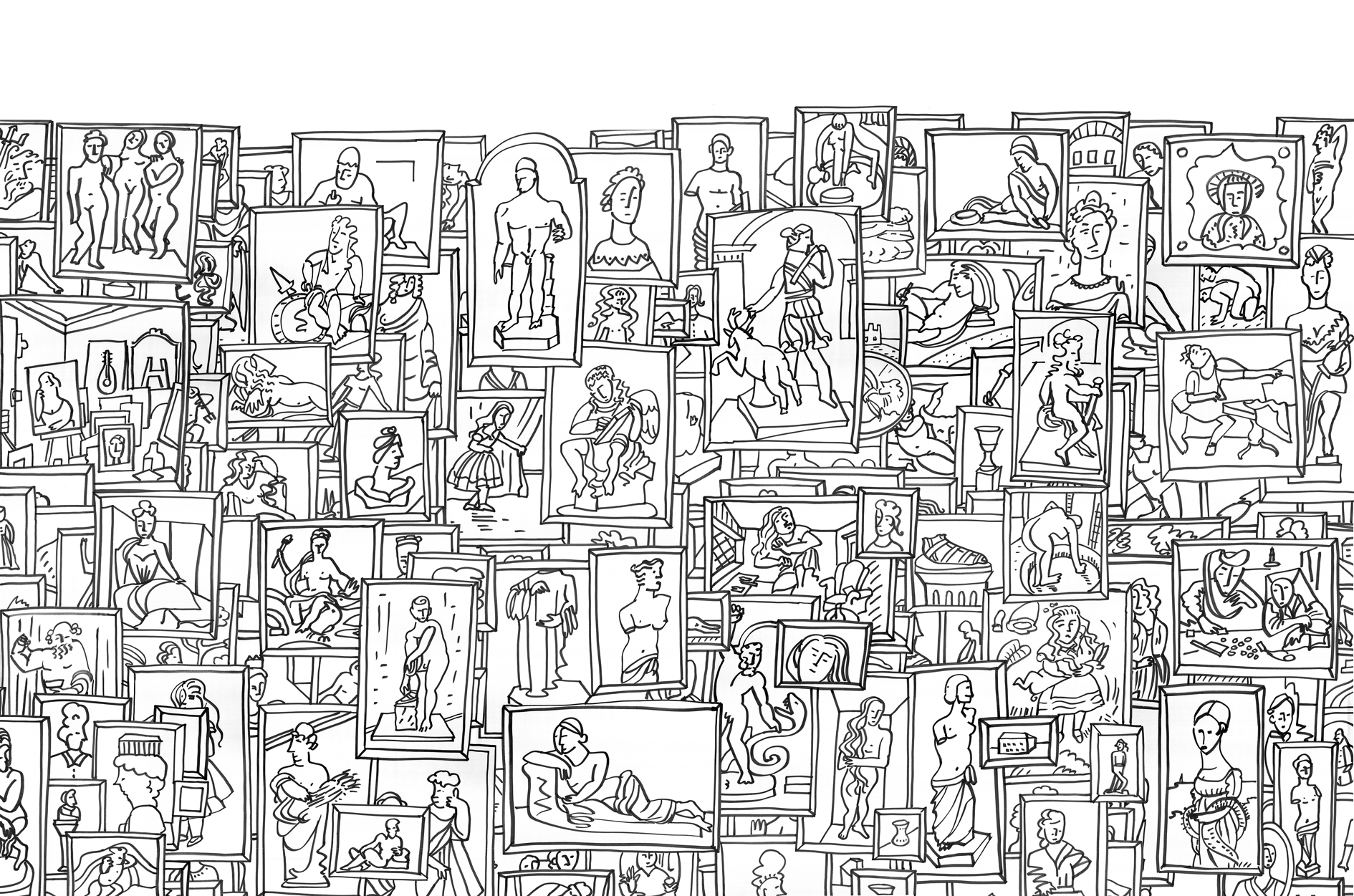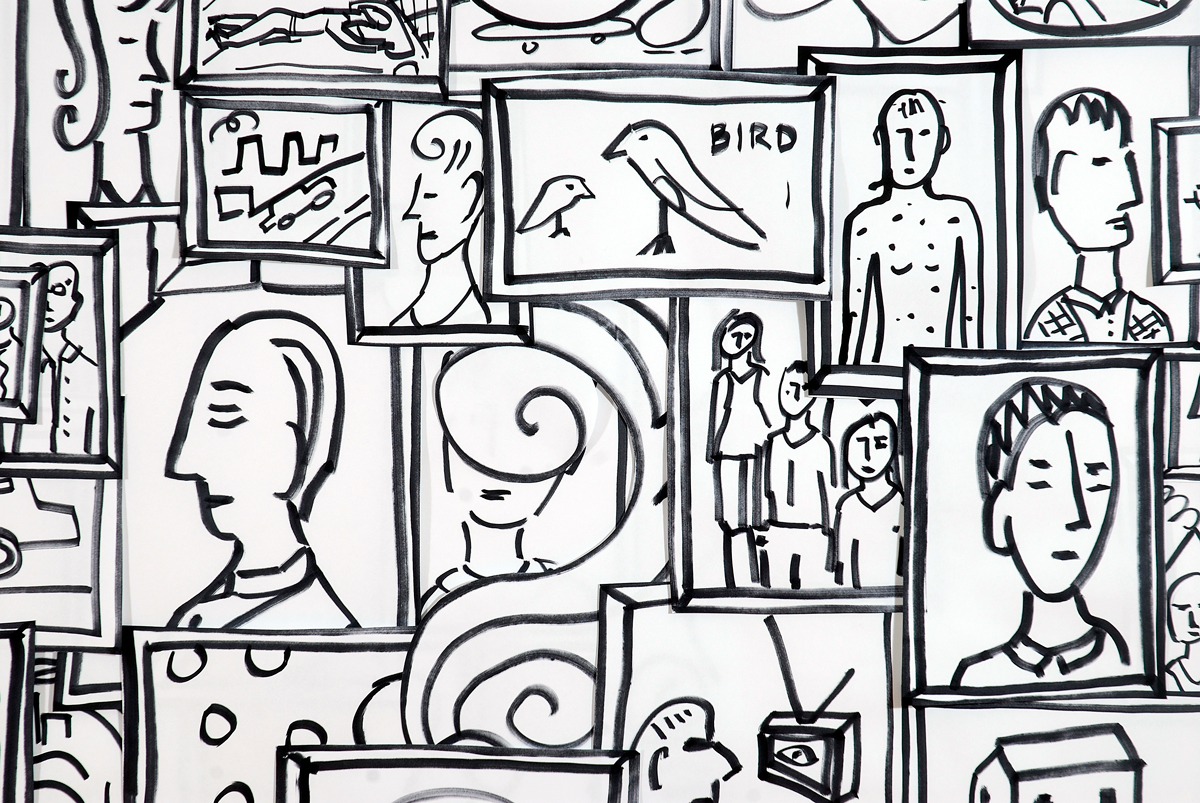Sadie Chandler
The Rules
House Rules book
Buildings
Framework
Art History
The Factory
Wallpaper
City Life
Portraits
Houses
About
Instagram
©Sadie Chandler

Vessels, 2019, ink on paper
Wallpaper
The wallpaper works are a way of making a lot very large images with simple means. Black outlines of people and objects are sketched onto paper and cut out, then pasted directly to the wall.
These can remain up for years or they can be temporary installations to be peeled off the wall and destroyed at the end of an exhibition. It is a bit sad to see them go, but that’s life.
Inspired by street art paste-ups and advertising posters that are torn down and plastered over repeatedly, these wallpaper works bring together seemingly random and unrelated references. They form a sort of dictionary, a compendium of images, a study of images rather than original things.
These can remain up for years or they can be temporary installations to be peeled off the wall and destroyed at the end of an exhibition. It is a bit sad to see them go, but that’s life.
Inspired by street art paste-ups and advertising posters that are torn down and plastered over repeatedly, these wallpaper works bring together seemingly random and unrelated references. They form a sort of dictionary, a compendium of images, a study of images rather than original things.


Arcade, 2019, ink on paper





The Weight of Images, 2017, ink marker on paper, installation detail Unfinished Business @ ACCA, Melbourne
The Weight of Images, 2019,(detail)

Things that I’m interested in looking at are paintings of all sorts, but mostly figurative, classical Greek sculptures, reclining nudes, images of women. Studies of works by the old masters and contemporary artists are found among the doodles with recognisable references, from Renaissance art to abstract paintings, portraits, disasters from the newspaper and all the art works that have been important and now fill up storage space.
The really good reference images are easy to draw. My jotting is a test of sorts. If an image can withstand being translated into a quick sketch, then I think that it has got more chance of being an image that will stand the test of time.
The really good reference images are easy to draw. My jotting is a test of sorts. If an image can withstand being translated into a quick sketch, then I think that it has got more chance of being an image that will stand the test of time.


The Classics, 2015, ink on paper (detail)

The Classics, 2015, ink on paper

Paperwork, 2016, ink on paper
 Works on Paper, 2007, ink on wallpaper, installation detail @ Austral Avenue
Works on Paper, 2007, ink on wallpaper, installation detail @ Austral AvenueSadie Chandler Works on Paper 2007 @ Austral Avenue
by Jane O’Neill
by Jane O’Neill
There is a faded glamour to Sadie Chandler's imagery that prompts one to think of New York in the 1940's. As in the world inhabited by Damon Runyon's people, here every male is a guy and every female a doll.
For this exhibition the main wall of the gallery oozes forth with black and white drawings that appear to have been made with a feverish sense of urgency. The individual works vary widely in content but are united by a bold animated style. Mainly we find portraiture: Chandler's familiar coquettes with elaborate hairstyles, and their chiselled masculine counterparts. There is also an undercurrent of tragedy: houses burning, graveyards, car crashes and ominous looking nuclear power stations. There is abstraction too: playful, geometric shapes are squashed into thick frames in such a way as to render impotent any capacity to arouse contemplation. The overall effect is of a stream of consciousness that shifts unapologetically between the political and the personal.
The title Works on paper might conjure expectations of delicate watercolors on Arches paper, but Chandler has drawn these works with black felt-tipped markers upon standard A4 photocopy paper. The pieces have been stuck to the wall with blu-tac. They overlap each other in an extreme version of a salon hang. Her process rejects elaborate or expensive means. There is an economy to the simple methods employed that extends to the installation period: Chandler would only hang works to the height she could comfortably reach from standing on a chair. One of the strengths of this work lies in the artist's capacity to mimic a setting of opulent grandeur with such crude materials.
The wallpaper of pictures plastered one atop another evokes the constant inundation of imagery we are subject to. These days it resembles the way computer screens bubble forth with layers of data. The work alludes to the impossibility of processing the extraordinary amounts of visual information that surround us. In particular, it strikes a chord with those who devote their careers to art, and is a bittersweet reminder of the exhaustion that comes from over exposure to exhibitions. The artist applied this technique most recently in an exhibition at RMIT Gallery on the topic of Elvis Presley. In this case, the wallpaper features a collection of Elvis-related imagery; sequinned trousers, records, gravestones, sunglasses, sideburns…the effect was perfectly suited to the ubiquitous nature of the musical icon.
We see in the work an interest in, and influences from a number of artists. There is the development of a bold graphic style as in the work of Julian Opie. There is an interest in the dominant visual nature of frames, as explored by Alan McCollum in his Plaster Surrogates series from the early eighties. And while the artist might reject the comparison, there is a resemblance to the striking brown and white installations of text panels by Robert MacPherson, with whom Chandler shares the capacity to execute a masterpiece a minute.
Sadie Chandler is not an artist to take herself too seriously. This is expressed through the keen sense of humour which she brings to the jumbled world of caricatures, landscapes and abstract scenes within the work. Given the self-importance that is attached to so much contemporary art, such wry modesty is refreshing. What is singular about her position, is that the resistance to the exploration of 'issues' through artwork is not expressed via the blank colour planes of minimal abstraction, but through an overwhelming proliferation of imagery.
There is a mystery to these installations that is not immediately recognisable. Each subject in every portrait is depicted with their eyes closed. Are they asleep, demure, or simply lost in their own thoughts? At any rate there is something withheld from the viewer. Also hidden within each installation are disembodied eyes; images based upon the eye of profidence that is depicted on the American dollar note. These eyes act as a reminder, that no matter how much looking we do, we too are always being observed.
For this exhibition the main wall of the gallery oozes forth with black and white drawings that appear to have been made with a feverish sense of urgency. The individual works vary widely in content but are united by a bold animated style. Mainly we find portraiture: Chandler's familiar coquettes with elaborate hairstyles, and their chiselled masculine counterparts. There is also an undercurrent of tragedy: houses burning, graveyards, car crashes and ominous looking nuclear power stations. There is abstraction too: playful, geometric shapes are squashed into thick frames in such a way as to render impotent any capacity to arouse contemplation. The overall effect is of a stream of consciousness that shifts unapologetically between the political and the personal.
The title Works on paper might conjure expectations of delicate watercolors on Arches paper, but Chandler has drawn these works with black felt-tipped markers upon standard A4 photocopy paper. The pieces have been stuck to the wall with blu-tac. They overlap each other in an extreme version of a salon hang. Her process rejects elaborate or expensive means. There is an economy to the simple methods employed that extends to the installation period: Chandler would only hang works to the height she could comfortably reach from standing on a chair. One of the strengths of this work lies in the artist's capacity to mimic a setting of opulent grandeur with such crude materials.
The wallpaper of pictures plastered one atop another evokes the constant inundation of imagery we are subject to. These days it resembles the way computer screens bubble forth with layers of data. The work alludes to the impossibility of processing the extraordinary amounts of visual information that surround us. In particular, it strikes a chord with those who devote their careers to art, and is a bittersweet reminder of the exhaustion that comes from over exposure to exhibitions. The artist applied this technique most recently in an exhibition at RMIT Gallery on the topic of Elvis Presley. In this case, the wallpaper features a collection of Elvis-related imagery; sequinned trousers, records, gravestones, sunglasses, sideburns…the effect was perfectly suited to the ubiquitous nature of the musical icon.
We see in the work an interest in, and influences from a number of artists. There is the development of a bold graphic style as in the work of Julian Opie. There is an interest in the dominant visual nature of frames, as explored by Alan McCollum in his Plaster Surrogates series from the early eighties. And while the artist might reject the comparison, there is a resemblance to the striking brown and white installations of text panels by Robert MacPherson, with whom Chandler shares the capacity to execute a masterpiece a minute.
Sadie Chandler is not an artist to take herself too seriously. This is expressed through the keen sense of humour which she brings to the jumbled world of caricatures, landscapes and abstract scenes within the work. Given the self-importance that is attached to so much contemporary art, such wry modesty is refreshing. What is singular about her position, is that the resistance to the exploration of 'issues' through artwork is not expressed via the blank colour planes of minimal abstraction, but through an overwhelming proliferation of imagery.
There is a mystery to these installations that is not immediately recognisable. Each subject in every portrait is depicted with their eyes closed. Are they asleep, demure, or simply lost in their own thoughts? At any rate there is something withheld from the viewer. Also hidden within each installation are disembodied eyes; images based upon the eye of profidence that is depicted on the American dollar note. These eyes act as a reminder, that no matter how much looking we do, we too are always being observed.